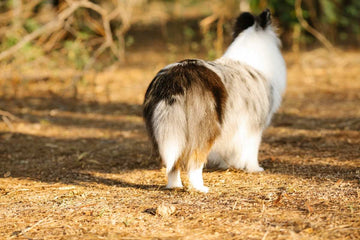
Dogs’ tails are more than fluffy appendages—they’re assets that serve multiple purposes. They help with balance, aid in quick turns, and, perhaps most importantly, act as part of a dog’s communication system. A wagging tail means much more than most people think.
Many dog owners assume a wag is always a sign of a happy dog, but dog body language is far more complex. Different tail wags, from a slow wag to a fast wag, carry different messages about what a dog is feeling. Even the direction of the wag—whether to the right side or left side—can signal different emotions.
Why does this matter? Because paying close attention to your dog’s signals can strengthen your bond, prevent misunderstandings, and improve dog training and care. By learning to decode what a dog’s tail is trying to tell you, you’ll better understand whether your dog is greeting you, feeling threatened, or giving a clear warning you shouldn't ignore.
The Purpose of a Dog’s Tail
Before diving into meanings, it helps to know why dogs even have tails.
Physical Function: Tails act as a counterbalance, helping dogs run, jump, or shift direction. For many dogs, this balance is essential during play, hunting, or agility work.
Communication Role: Tails are essential in a dog’s communication. Along with facial expressions and posture, tails signal mood and intent. A tucked tail may mean a scared or anxious pup, while a high tail wag can signal alertness.
Emotional Signals: Various studies and animal behavior research show that tail language is deeply tied to emotional states. Observations by certified dog trainers and everyday dog owners confirm that tails are as expressive as a dog’s eyes or ears.
The meanings behind tail movements come from decades of canine behavior studies. Researchers have analyzed how even the direction of the wag links to emotional states. Veterinarians, trainers, and behaviorists use these observations to guide dog training and safe interactions. Dog owners also notice patterns—like how a dog’s signals change during training sessions, playtime, or rest—and these observations often align with professional findings.

Understanding Tail Positions
Just like posture or facial expressions, the position of your dog’s tail offers valuable clues.
Tail Up - A raised tail often indicates confidence, alertness, or dominance. However, if the tail is stiff and bristled, it may also signal a perceived threat or aggressive intent.
Tail Down - A tail that hangs low can mean relaxation or submission. However, in a fearful dog, it may also point to sadness, insecurity, or stress. A tucked tail is a stronger warning sign of fear or anxiety.
Neutral Position - When the tail sits naturally at mid-level or aligned with the spine, the dog is likely content and at rest. This is often the baseline to compare other tail changes against.
Tail Movements and Emotions
Tail position alone doesn’t tell the whole story. Movement, speed, and energy level all play a role in decoding a dog’s behavior.
Wagging While Standing: Context is key. A fast wag that’s loose and sweeping often signals a happy dog or excitement. A slow wag, on the other hand, may reveal caution, uncertainty, or even tension. Dog owners should consider the full picture before assuming.
Wagging While Lying Down: Many dogs wag gently while lying down as a low-energy hello or a relaxed acknowledgment of your presence. It’s a friendly dog gesture, even when their body is at rest.
Sad or Low Tail Movements: A tucked tail pressed against the belly usually indicates a scared or fearful dog. A drooping tail without tucking may show sadness, insecurity, or fatigue. Both are signals that a dog is feeling vulnerable.
Direction of Tail Wagging
One of the most fascinating findings in canine body language is that even the direction of the wag could be telling us something.
Wagging to the Right (Right Side): Studies show that dogs wag more toward the right side when they are happy or excited, such as when greeting their favorite person.
Wagging to the Left (Left Side): Wags to the left side are more often linked with stress, uncertainty, or a perceived threat. A left-leaning wag might mean your dog doesn’t feel fully comfortable.
Always consider tail direction alongside the rest of the dog’s communication—posture, facial expressions, and energy level—before making assumptions.
Aggressive Tail Signs of a Dog
Recognizing when a tail signals aggression is critical for safety.
Stiff, Upright Tail: A raised tail held rigidly is a warning sign of dominance, alertness, or aggression. The dog may feel threatened and could lash out if pushed.
Straight Out and Rigid: This posture suggests tension and a readiness to react. In combination with raised hackles or growling, it shows the dog is preparing for confrontation.
Reading a tail in isolation isn’t enough—always pair tail signs with the rest of the dog’s behavior to understand the full message.
Are Dogs’ Tails Supposed to Be Up or Down?
There isn’t one correct answer. Different breeds carry their tails differently. Huskies and other Spitz breeds naturally have curled or high tails, while Greyhounds typically keep their tails lower. What matters most is recognizing changes from your dog’s neutral position. A suddenly raised tail or a tucked tail should get your close attention, as it signals a shift in how the dog is feeling.
Practical Takeaway for Pet Owners
Dog’s signals are nuanced, and tails are only part of the story. Don’t rely solely on tail language—always watch for accompanying facial expressions, posture, behavior, and even the ear position.
-
Pay attention to context: Is your dog in a familiar space or facing a perceived threat?
-
Consider energy level: Is the wag fast and loose, or slow and stiff?
-
Use this knowledge in dog training: Understanding what a wagging tail means can help during training sessions, playtime, and socialization.
Recognizing different tail wags helps owners respond appropriately, whether that’s giving reassurance to a scared dog, calming an excited pup, or backing off from an aggressive stance.
Understanding tail signals is just one part of responsible pet care. Gotta Go Grass is on a mission to help pet parents better connect with their pups’ needs and behaviors while providing dog grass pee pads for everyday use and other pet-friendly solutions.
Final Thoughts
Dogs’ tails aren’t just “happy” or “sad” indicators. They’re complex communication tools that reveal how a dog is feeling at any given moment. From a fast wag on the right side that shows joy, to a tucked tail that signals fear, every movement carries meaning.
By paying close attention to your dog’s body language—tail, posture, and expressions—you can respond appropriately, prevent conflicts, and create a more supportive environment. Learning to read your dog’s behavior builds trust, strengthens your bond, and makes life happier for both you and your four-legged friend.




